当前城市:淄博[切换]
- 手机雅思无忧

扫码登录
今天雅思无忧小编整理了剑桥雅思听力5test1答案 雅思听力四个部分别考什么相关信息,希望在这方面能够更好帮助到大家。
雅思听力四个部分别考什么?雅思四个部分考什么? 对于初次接触雅思考试的烤鸭们,提到雅思听力相信考生第一个想知道的问题,我就这个问题带大家一起来看看《雅思官方指南》怎么说的吧。
雅思听力四个部分别考什么?
Section 1 A conversation between two people about a general topic with a transactional purpose (e.g. finding out information about travel).
Section 2 A monologue or prompted monologue on a general topic with a transactional purpose (e.g. giving information about events in the community).
Section 3 A conversation between two or three people in an academic context (e.g. a student and a tutor discussing an academic problem).
Section 4 A monologue in an academic context (e.g. a lecture).
《雅思官方指南》对听力的具体解析内容如下:
Section 1:两个人就一个普通话题进行以信息交流为目的的对话(比如:发现旅游信息)。
通过对历年真题的分析,我们发现历年的考题都是以旅游为最多,2021 年出现频率高达17 次。考生在2021 年毫无疑问要把旅游相关的单词和考点弄清楚。考生可能还要问其他普通话题包括什么呢?让我们看看《雅思官方指南》给出的八套练习题。本部分的话题依次是:旅游、 故事 比赛信息、健身、夜校课程、失物招领、租房、酒店预订、活动信息。考生从中可以看出这跟剑桥系列并没有区别。当然这些话题并不能包含 section 1 话题的全部。如果结合2021 年的考试情况稍作拓展, 还有可能考到的话题也可以包括求职、邮局、银行、医院等等。
Section 2:就一个普通话题进行信息交流的独白或者有提示的独白(比如:给出社团活动信息)。
先看看《雅思官方指南》的八套练习题的话题内容:旅游介绍、海洋中心介绍、酒店介绍、花园整改介绍、公园介绍、警方给出的一个指南、资料中心介绍。社团活动信息过于笼统,从《雅思官方指南》练习题中可以看出主要是以地点介绍为主,这一点契合2021 年的雅思考试情况,在2021 年的48 次考试*计23 篇听力以旅游景点的介绍为主。其大体考试思路是介绍这个地方的背景知识、参观的时间、地点安排、布局介绍和注意事项。组织考察的基本思路是、时间、地点、内容和注意事项。另外一般而言, section 2 通常会有一到两处节奏忽然变快的现象,考生尤其要注意对速度的把握,预测节奏快的地方也不难,基本上空间距离比较近的两个题之间节奏偏快。
Section 3:学术场景下的两到三人对话(比如:师生之间的学术问题讨论)。
《雅思官方指南》给出的八套练习题的话题分别不一样。概括起来就是本部分是以学生的作业和课程讨论为主要话题,具体细分的话还可以归类于五大话题即为:论文、展示、调查、项目和选课,此五大话题能占到本部分出题的90% 左右。考生可以根据历年考题所涉及的本部分的高频词汇记忆增加对本部分语言的敏感,并通过背景知识的扩充增加对本部分的精准把握。
Section 4:学术场景下的独白(比如:老师讲课)。
《雅思官方指南》给出的八篇练习依次是:早期人类制陶、展示准备、头发讲座、新西兰毛利人风筝*、岩画、朋友影响、烟花历史和乌鸦研究。不难看出本部分的难度在于话题的多样性,所以也是四个部分中最能体现考生实力的一个部分,考生要想在本部分发挥出自己的最佳水平,一个切实可行的理念就是保证容易的题目答题正确,本部分的两类容易的题目即为数字题和列举题,考生不妨在读题时对题目进行难易分级,通过做标记的形式在做题时重点攻克,最终取得预期的成绩。
雅思听力读不懂题目一样做
这几年教授雅思听力,在这一过程中常常遇到些基础欠佳的同学总是因为单词量或者基础的问题被雅思听力难住。雅思考生因为生词不认识,读不懂题目,进而该题甚至整个section的题目全部报废。本文会帮助考生帮助分析读题方面常出现的问题,并且提出一些考场上切实可行的解决 方法 。
众所周知,雅思考试一共考察学生4种能力,即听,说,读,写;其实雅思主办方在考试中巧妙地考察了学生另外一种英语基本能力,那就是翻译的能力。拿听力考试举例,考生首先需要读懂题干,正确理解题目含义,这个就是学生把英文(源语)解码转化生成中文(目的语)的过程,学生在不知不觉中完成了笔译员的工作。而当听力音频播放的时候,学生又充当起口译员的角色;把听到的英文 句子 翻译成句意通顺,符合中文表达习惯的译文,和口译员唯一不同的地方是,学生把翻译好的句子自己进行内部消化,而不是把译文念给其他听众。所以说,听力所考察的内容,远没大家想象中的那样简单。但是,如果我们可以从读题中获得充足的信息,可以有效帮我们缓解听力答题过程中的压力。
1.如何读题?
在第一节强化课开始的时候,我就会跟学生强调一点,读题是否准确,对能不能在原文中抓住正确答案起着至关重要的作用。根据我的做题 经验 总结 ,读题答题分为2个步骤,第一步是通读题干,进行英译中的工作;第二步,在已经理解了题干的基础上,对本题进行预测工作。
1)通读题干,进行英译中
在这个过程中,就会出现若干个小问题,比如大家都会或害怕遇到的问题就是题干中出现不认识的生词。这该如何处理呢?首先,不要害怕生词,因为有时即使不认识的单词也并不一定给读题带来困扰;比如剑4-3-2中的一道选择题:
例:how many circuses are there in the festival?
A. one
B. two
C. several
每当课上给学生做这道练习题目的时候,学生总是会习惯性地问我:“老师,circuses什么意思啊?”在学生看来,读题就是要把题目中的每一个单词意思都弄懂,然后再进行字对字形式地翻译。其实,我们在碰到生词的时候,首先要猜测下单词的读音,不论发音是否正确,而不是非要知道这个词什么意思。这是因为,首先,像这种不认识的词,而且是名词词性的生词一般会在原文中原词重现,所以当知道单词的发音后,就方便我们回到原文大致定位该题出现的位置了。接下来,我们进行翻译的动作了。有的同学问,发音知道了,可意思不知道,还是不能翻译啊?这个其实可以通过意思转化来解决,比如该题中的circuses一词,经过判断后得知是名词的复数形式,那么在翻译中,只要是名词词性的生词我们都可以用中文中的“什么”来替换生词的含义,最后放在原文中得出的意思就是:有多少个“什么”在festival中;而通过阅读选项可以得知,此题询问的是具体数量,所以我们要做的工作就是通过生词发音定位答案出现的位置,以及辨识和生词有关的数量是否正确。在知道了如何处理生词的步骤后,让我们来看看听力原文中是如何进行描述的。
“For today’s report though, Geoffrey, I’m looking at some of the theatrical events that you might like to see; in particular, at this year’s theme-Circuses1.(此处原词第一次重现,学生需要再此处提高警惕,答案即将登场). I’m going to tell you about two Circus2 (原文中生词第二次出现) performances, but there are plenty of others in the programme”.
通过生词的发音我们就可以定位它在原文中的位置了,而通过题干中的关键词in the festival和原文中转折词but,plenty of 和in the programme的出现,我们就可以把正确答案several选出来了。
如果在题干中碰到动词不认识又该如何处理呢?我们接着来看例题:
例:Where does Circus Romano perform?
A. in the theatre
B. in a tent
C. in a stadium
这道题中除了上面例题中的circus,还出现了一个生词perform(虽然此生词为常用词汇,但此处假设有同学视之为生词),我们刚才讲过的内容就可以用上啦,猜测circus和perform 两个词的发音,把名词circus置换成中文中的“什么”,那perform又该如何处理呢?通过对题目的理解,does为一般现在时的助动词,Romano一词首字母大写,所以可判断其为名词,那么显然剩下的perform就是本句话中的动词了;而且句中疑问词where是对动词提问。我们可以把不认识的动词perform转化成中文中的“怎么”的意思,带入句子,得出的译文为:“什么”在哪“怎么”了,通过阅读选项的意思加以验证题干,果然这道题的出题点就是问和Romano有关的地点。
2)进行题目预测
在从英文题干提取出中文意思后,我们就要对题干中空格处进行预测工作了。在预测环节我们要进行2个步骤,第一是对空格处词性或答案组合进行预测;第二步是*此题是不是会出现听力陷阱。第一个工作我们应该已经不陌生了,比如看到空格前如有$或是?符号,那么空格处填写的内容一定是和数字有关,如果是单词address出现在空格前,那么这道题的答案一定是数字加单词的组合,对于第一步来说,能够预测到这里已经算是合格了,接着让我们来看第二步。比如某道题中题干中除了之前碰见过的address,还有个单词present,那么我们就要来想一想了,多出个present这个词的用意是什么呢?present的意思是“现在的,当前的”,那么题干问“当前的地址”,我们能从其中察觉到此题话中有话,所以在听原文的时候要对此题特别重视了。当原文中提到Where do you live? 的时候,一个说话人会说我之前住在_X,但是那里环境不好,太吵了,所以我搬到了_X,我现在的地址是_X。果不其然,我们这道题中碰到了第一部分中如幽灵般存在的听力陷阱,如果大家做好准备的话,可以很轻松地把陷阱跳过去,直接面对正确答案了。
通过上文的介绍和例题的讲解,我相信大家应该对如何读题以及在实战中如何处理生词的问题有了一番了解和新的认识,总之,希望借由此文唤起大家对读题重要性的重视,并在考试中能运用文中提到的方法去客服读题困难,最终取得自己满意的成绩。
雅思听力填空题解题技巧
雅思听力目前由选择题和填空题两大部分组成。雅思听力的填空题相对于选择题,大多数情况下只需找到信息点,不需全句听懂就可以完成题目,是相对较好提分的题型。然而section3和section4的填空题却给大多数考生带来困扰,甚至成为很多人突破7分的瓶颈。那3,4部分的填空题究竟难在哪里,要以什么策略应对呢?以下以剑桥雅思真题为例,进行解析。
雅思的填空题相对于选择题,属于略为简单的题型,因为考生大多数情况下只需找到信息点,不需全句听懂就可以完成题目,且相对于选择题,填空题的陷阱较少,只要有一定的词汇基础,再注意细节,是相对较好提分的题型。
但是很多同学反应:section1和section2的填空题的确简单,但是从section3开始,就有点跟不上趟了。
今天,我就集中讨论一下section3 和 section 4出现的summary与sentence completion的应对技巧。
同样是填空题,为什么section 1和section2的那么简单呢?三四部分的填空难,是因为节奏快?词汇量要求高?
其实你会发现,即使到了第四部分,两道题答案中间的间隔也不是很短;还有, 虽然录音原文会涉及一些偏僻的词汇,但是要填的空90%都在4级甚至是高考词汇之内。那为什么答案总是那么一闪而过,与你失之交臂呢?
其实3,4部分填空的难点,尤其是summary completion 的考点,在于录音和题目文本的差距大。试想一下,如果填空听到的录音和题目文本一模一样,只是挖出了几个空给你填,是不是瞬间变得容易很多。那么,这所谓的差距体现在哪些方面呢?
1. 关键词乱序---- 即答案前置;关键词后置;这样等你终于等到了关键词,答案已经过去了
2. 关键词替换:比如把financial affairs替换成economic situations
3. 句型大幅调整
4. 逻辑关系的调整
例如:
剑桥雅思5, Test1, Section4(summary completion):
原题:
Research indicates that many women only think about their financial future when a 36-----------occurs. This is the worst time to make decisions…... A good way for women to develop their 38---------- in dealing with financial affairs would be to attend classes in 39------------.
题目难点:
1. 定位词后置+定位词替换+句型转换(36题)
录音:The research indicates that at present for women it takes a crisis to make them think about their future financial situation.
a. 定位词financial future在答案出现之后才出现,容易漏听
b. 定位词financial future不是以原词出现,而是替换成了future financial situation
c. 句型上的较大调整: women do sth when ___occurs
替换成了it takes ___ for women to do sth
d. 逻辑替换:反向推理(38题)
题目: a good way is to develop __________ in dealing with financial affairs
录音: Woman avoid dealing effectively with their economic situations because of a lack of confidence …
------- 女性不能有效handle经济事务是由于 a lack of confidence
反向推理:正因为做不好的原因是缺乏confidence, 才需要发展confidence
分析完了考官的出题思路, 看过了一篇有难度的summary completion, 考生更关心的是:我的基本功也不是一天,两天可以大幅提升的,就我现在的水平,给我临场可以多抓两道题的应试技巧吧。
好,那你就应该做到这几点:
1.读题时找准关键词 (虽然一开始接触雅思听力就知道要找关键词,但你真的找对了吗?)同时在心里默默准备2个关键词的替换说法
那什么才是正确的关键词同时也常常是雅思听力的考点呢?其实很简单:
时间,地点,名词,比较级,做高级,表程度的词(如a large part; a great number)和表示否定意义的词。需要注意的是:要找每一题新鲜出来的信息,反复出现的信息(如topic对象)不能选择,因为这根本起不到定位作用!
2. 预测空格要填的是什么:注意:细化很重要!!!例如,只想到了要填一个名词还不够,能够想到是一个location或者是一项activity,你听题是就更能做到有的放矢!
3. 观察题目布局:比如前后两道题中间隔了好几句话,那么,请期待录音出现于答案无关的大段废话吧, 对于这些废话, 无需听懂,只要时时刻刻跟到录音讲到哪里就可以了;
而如果两个空中间的空隙较小,那么请期待着两个答案在录音里出现时会间隔很短。
4. 听录音时积极搜索关键词和符合出题空的词,可以多写下几个词,在整理答案的时候挑一个出来 (这也可以帮助我们应付答案前置的情况)
举例说明:
剑6,test 4, section4:
36. One threat to the lions in the sanctuary is ___________
学生常常错误选取“lions”或者 “sanctuary”作为关键词,但是lions是 文章 讨论的主题,sanctuary是后面五道填空的副标题,都不是新鲜的信息,所以不能选择。
这里真正的关键词是:“threat”
接着细化预测:既然是threat:那么一定是一个名词(并且不是什么好东西)
接着听题时积极搜索:(原文如下)
Despite living in the sanctuary, which makes them safe from hunters. They still face a number of problems that threaten their survival. One of these if the ever-present danger of disease.
很多学生会误填:hunters, 但是听题时应注意:“despite”(表让步,后面往往跟次要信息) “safe from hunters”(不受hunters迫害)——— 这些都明确告诉我们hunters不是答案
当听到problems that threaten their survival的时候,应该敏感地捕捉到关键词来了,然后顺藤摸瓜抓住“disease”----本题正确答案。
39. The lions sometimes__________, especially when water is short.
关键词:表时间的信息:when water is short
细化的预测:应该是 do sth (lions在缺水是可能做的一件事情)
积极搜索:(原文如下)
And they’ve even been known to attack humans, especially in times of drought.
听到狮子attack humans符合了我们刚刚要的do sth,应该积极地写下来,听到后面出现 especially in times of drought对应上了缺水这一关键信息点时,我们就知道答案就是attack humans.
以上,就是雅思无忧小编给大家带来的剑桥雅思听力5test1答案 雅思听力四个部分别考什么全部内容,希望对大家有所帮助!
雅思培训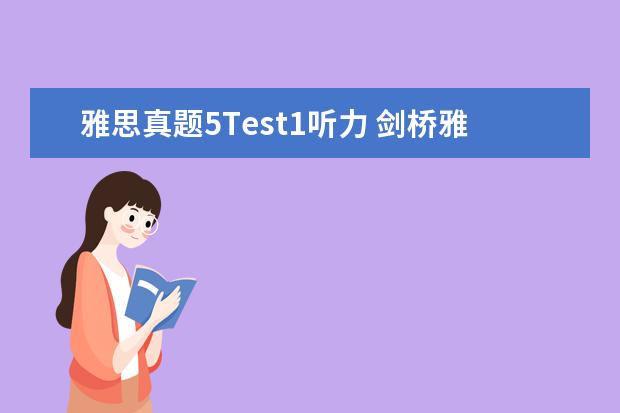 雅思真题5Test1听力 剑桥雅思5test1阅读21 35题求解释..详细一点 - 百度...
雅思真题5Test1听力 剑桥雅思5test1阅读21 35题求解释..详细一点 - 百度...
雅思考试主要是通过对考生听、说、读、写四个方面英语能力的考核,综合测评考生的英语沟通运用能力,实现“
2023年06月13日 14:30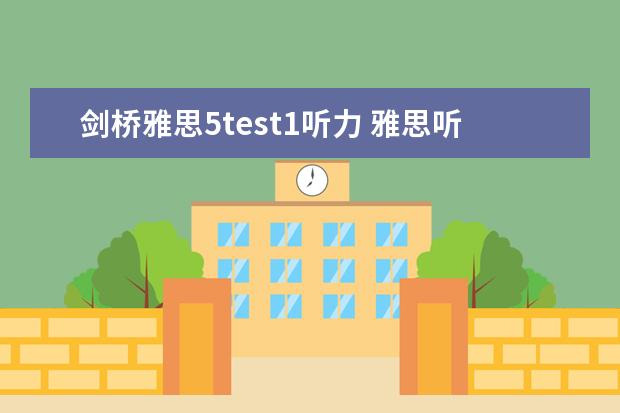 剑桥雅思5test1听力 雅思听力四个部分别考什么
剑桥雅思5test1听力 雅思听力四个部分别考什么
雅思听力快速提分技巧分享您好,我是专注留学考试规划和留学咨询的小钟老师。在追寻留学梦想的路上,选择合
2023年09月30日 03:46 剑桥雅思听力5test1 雅思听力四个部分别考什么
剑桥雅思听力5test1 雅思听力四个部分别考什么
2012年12月雅思考试:雅思听力干扰信息如何识别排除干扰信息是大家所要掌握的最核心的雅思听力答题方
2023年10月09日 08:31 剑桥雅思5test1答案听力 2023年5月11日雅思听力考试真题及答案
剑桥雅思5test1答案听力 2023年5月11日雅思听力考试真题及答案
雅思听力四个部分别考什么雅思听力四个部分别考什么?雅思四个部分考什么?对于初次接触雅思考试的烤鸭们,
2023年10月15日 10:07 剑桥雅思5test1答案听力 雅思听力四个部分别考什么
剑桥雅思5test1答案听力 雅思听力四个部分别考什么
雅思听力旅游场景出题点有哪些雅思听力中的场景是雅思听力考试的一大特点。场景的内容可以分为培训类(Ge
2023年10月15日 10:07 雅思真题5test1听力290 求9分达人雅思听力真题还原及解析 test1-6的答案谢...
雅思真题5test1听力290 求9分达人雅思听力真题还原及解析 test1-6的答案谢...
雅思考试主要是通过对考生听、说、读、写四个方面英语能力的考核,综合测评考生的英语沟通运用能力,实现“
2023年06月12日 20:26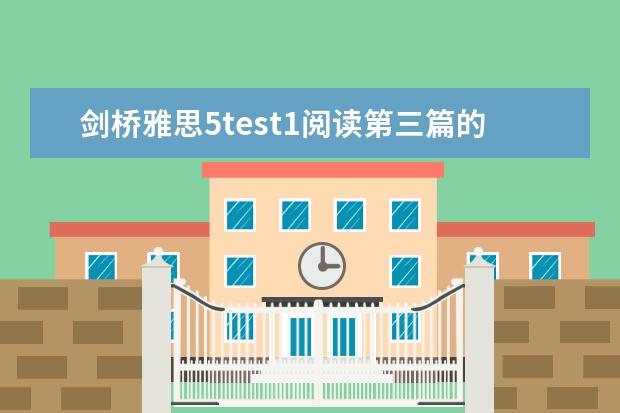 剑桥雅思5test1阅读第三篇的31题一直想不通(雅思阅读的出题规律解析)
剑桥雅思5test1阅读第三篇的31题一直想不通(雅思阅读的出题规律解析)
剑桥雅思5test1阅读第三篇的31题一直想不通原文可能正确联系,也可能错误联系,属于可能性缩小应当
2023年10月27日 14:53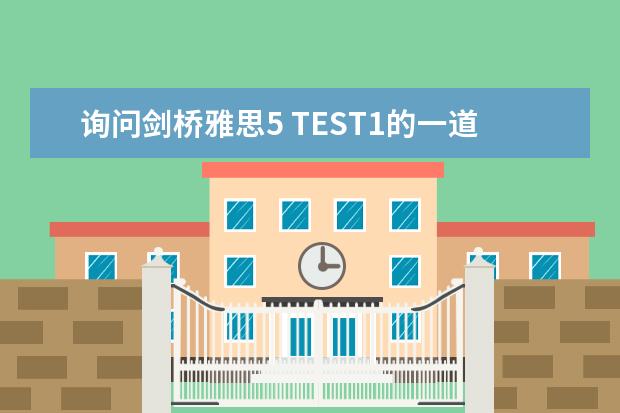 询问剑桥雅思5 TEST1的一道阅读题(剑桥雅思5test1阅读第三篇的31题一直想不通)
询问剑桥雅思5 TEST1的一道阅读题(剑桥雅思5test1阅读第三篇的31题一直想不通)
询问剑桥雅思5TEST1的一道阅读题这个问题我也没有得到一个准确的答案。据我目前的理解是,题目中有三
2023年10月30日 00:58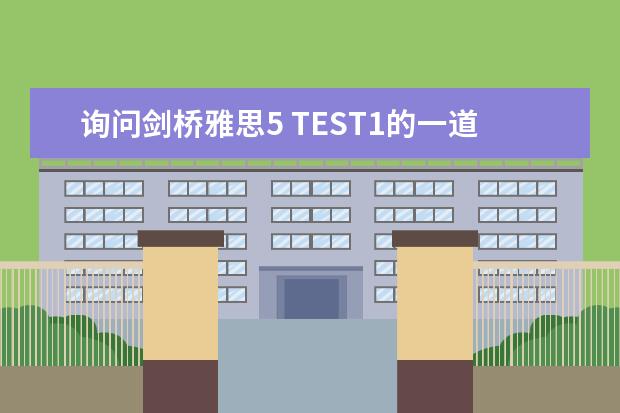 询问剑桥雅思5 TEST1的一道阅读题 剑桥雅思5test1阅读第三篇的31题一直想不通 剑桥雅思5 test2中阅读24~27题的解析,请大家帮帮忙啊!!!谢
询问剑桥雅思5 TEST1的一道阅读题 剑桥雅思5test1阅读第三篇的31题一直想不通 剑桥雅思5 test2中阅读24~27题的解析,请大家帮帮忙啊!!!谢
询问剑桥雅思5TEST1的一道阅读题这个问题我也没有得到一个准确的答案。据我目前的理解是,题目中有三
2023年10月30日 07:34 2023年7月10日雅思阅读部分考试答案 剑桥雅思4 test1 阅读passage3 答案问题 剑桥雅思5test1阅读第三篇的31题一直想不通
2023年7月10日雅思阅读部分考试答案 剑桥雅思4 test1 阅读passage3 答案问题 剑桥雅思5test1阅读第三篇的31题一直想不通
2023年7月10日雅思阅读部分考试答案您好,我是专注留学考试规划和留学咨询的小钟老师。在追寻留学梦
2023年11月07日 06:40